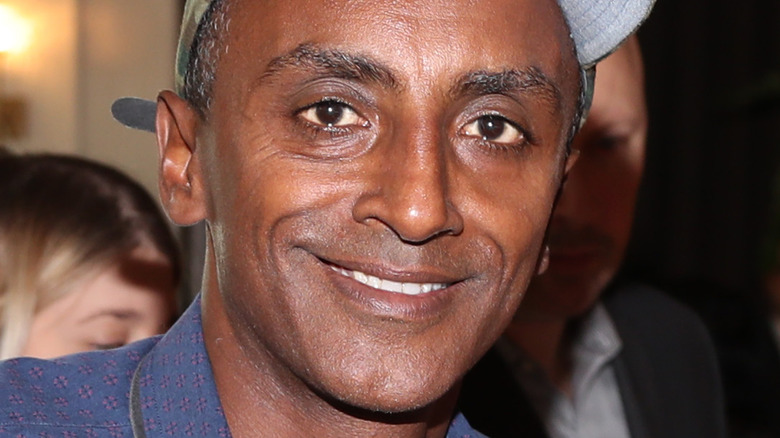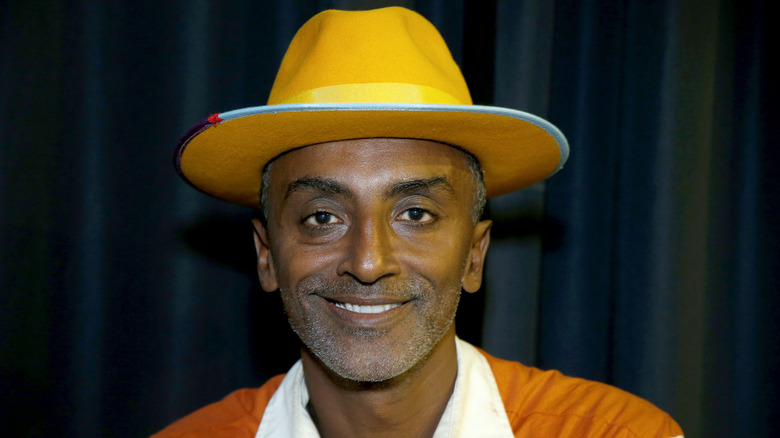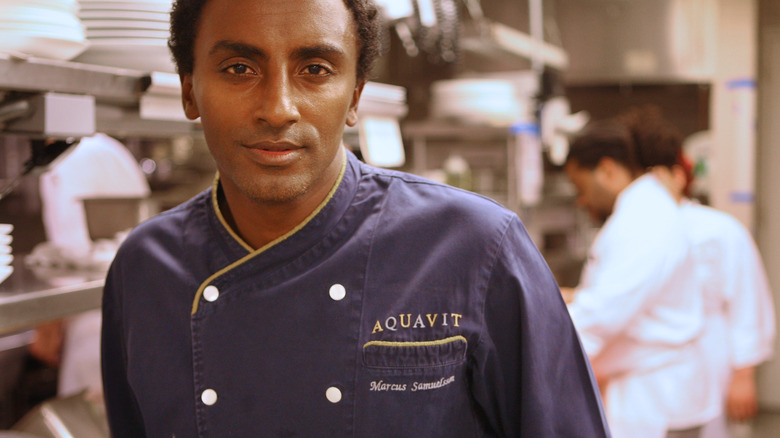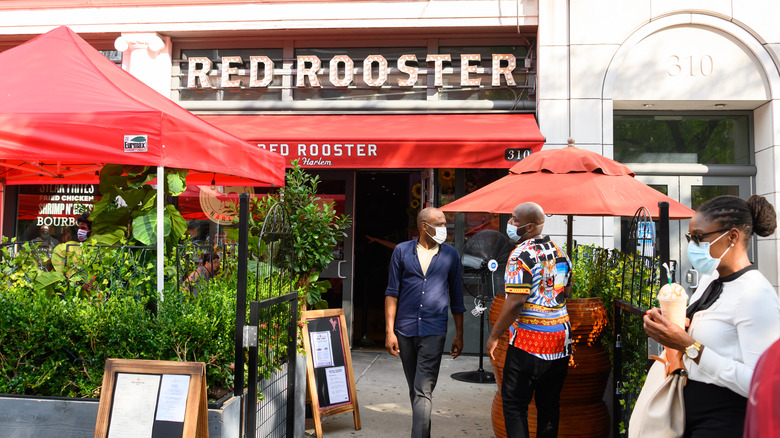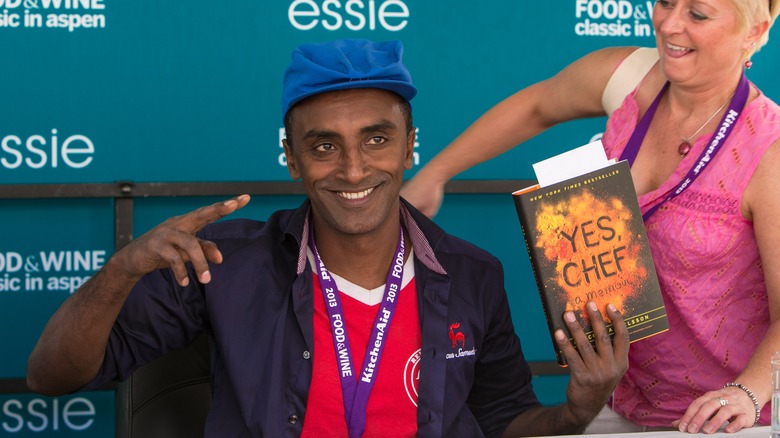The Untold Truth About Marcus Samuelsson
Marcus Samuelsson is one of the culinary world's brightest stars, and his impact is only increasing. The honors he received from the James Beard Foundation track his trajectory working in restaurants, from Rising Star Chef in 1999 to Best Chef: New York City in 2003 to Best International Cookbook in 2007. He has authored several cookbooks and appeared on shows like "Iron Chef," "Chopped All-Stars," "The Today Show," "The Martha Stewart Show," and more (via Food Network). In his latest project, he will act as co-host and head judge on the new Peacock show "Top Chef Family Style" as kid chefs and their family members compete for the top spot.
As a chef, he's driven to embrace local food culture while prioritizing fresh, affordable meals. His family's ties to Ethiopia, where he was born, and Sweden, where he grew up, deeply inform his cooking. He deeply values the culture of New York, the city he immigrated to when first starting his career, and he is inspired to reflect local culture in his restaurants (via the Marcus Samuelsson website).
It's clear that Samuelsson is one of the most important chefs right now, but how did he get to this point in his career? Find out below as we explore the untold truth of Marcus Samuelsson.
Marcus Samuelsson moved to the U.S. with just $300
Food was always important to Marcus Samuelsson, and he speaks openly about how his upbringing affected his future culinary style. "Food has always been in my life," he told "Fresh Air"s Dave Davies (via NPR). "Being born in Ethiopia, where there was a lack of food, and then really cooking with my grandmother Helga in Sweden," he said.
Samuelsson worked in restaurants starting as a teenager and discovered he was good at it. He went on to study at the Culinary Institute in Gothenburg and took apprenticeships at some of the best restaurants in Switzerland and Austria. He even worked at a Michelin-starred eatery helmed by the famous chef Georges Blanc. After all this preparation, Samuelsson decided to make a big move and begin a career in New York. He only had $300 when he made the move, and lived in a shared apartment and used a massage table as a bed in order to save money. One of the first things he loved about New York was the availability and proximity of so many different culinary styles from around the world (via CNBC).
The prestigious Swedish restaurant Aquavit in New York City, where he had served an apprenticeship a few years before, hired him as a sous chef in 1994 and his career began to take off.
Marcus Samuelsson found success as a young chef
When Marcus Samuelsson was just 24 years old, he got a big break that jump started his career. After working as sous chef at the Swedish restaurant Aquavit for only two months, he had the opportunity to take on the executive chef role after his predecessor died unexpectedly. Despite his young age, the circumstances and his experience working at renowned restaurants in Europe before coming to New York landed him the job (via CNBC).
The job was intimidating at first, but Samuelsson's efforts at Aquavit paid off. "I was nervous. I didn't want to be the one to take a famous restaurant like Aquavit down ... But I also knew that if I worked really hard, I could do it ... Eventually our tribe of misfits became our strongest weapon," he told NPR. Under Samuelsson's guidance, Aquavit received a three star review in The New York Times, making him the youngest chef to ever achieve that milestone.
Marcus Samuelsson's restaurants highlight local cultures
After achieving initial success, it was Marcus Samuelsson's dream to open his own restaurant. He has attributed his first steps at Aquavit and the attention he received while working as executive chef there as a confidence boost he needed to make his dream come true (via CNBC). He has gone on to build a dining and hospitality business that operates over a dozen restaurants and generated $75 million in revenue per year before the pandemic.
The most famous of his restaurants is Red Rooster Harlem, a crowning gem that truly represents what Samuelsson's passion for cooking is all about. The restaurant aims to celebrate the cultural roots and diverse culinary traditions of the neighborhood while contributing meaningfully to the community. "I live in Harlem and I feel like I have the opportunity to have a great restaurant in Midtown and a great restaurant in Stockholm—but I live in Harlem, I have access to food, and I feel like it's my responsibility to bring food that's affordable to our neighborhood, has the farm-to-table approach, and gives, inspires people in the neighborhood to come in," he told Eater.
In addition to serving great food, the restaurant also hosts musical performances and features artwork by local artists. Other locations of the restaurant are Red Rooster Overtown in Miami and Red Rooster Shoreditch in London.
Marcus Samuelsson won Top Chef Masters Season 2
Of course, in addition to his award-winning work as a chef and restaurateur Marcus Samuelson has also become famous for his features on television shows. In 2010, Samuelsson competed on the second season of "Top Chef Masters" and won. He donated the $100,000 prize money to the UNICEF Tap Fund to support their efforts to supply clean drinking water to people in Africa (via Eater).
He won against Susur Lee and Rick Moonen in a set of challenges that brought them through their journeys as chefs. The first dish was inspired by their first food memory. The second dish was the food that inspired them to become a chef. The third dish was something that described them as a chef. Samuelsson's African-inspired foie ganache was a standout and he told Eater it was his way of being true to his roots with lesser-known African flavors. He pulled through with 17 ½ points to win over the fan-favorite Susur Lee.
Inside Marcus Samuelsson's No Passport Required gig
Marcus Samuelsson has competed on culinary competition shows and been featured on other television programs, but he also hosts his own show about American cuisine. "No Passport Required" takes its viewers around the United States to different cities, where they can explore diverse cuisine from around the world.
The goal of the show is to highlight immigrant communities, their culture and traditions, and the leaders who have shaped them. The show features local artists, musicians, and storytellers, in addition to home cooks, to fully capture the community and share it with the world. It was produced by PBS and Eater, and aired from 2018 to 2019 (via Eater).
There are two seasons available to stream online at PBS. The first season has six episodes that feature the Middle Eastern community in Detroit, Vietnamese immigrants in New Orleans, Mexican food in Chicago, Indo-Guyanese people in Queens, Haitian culture in Miami, and Ethiopian residents in Washington, D.C. Season 2 explores Filipino, Armenian, Nigerian and West African, Italian, Chinese, and Cape Verdean communities in Seattle, Los Angeles, Houston, Philadelphia, Las Vegas, and Boston. The series definitely sounds worth a try, along with the new "Iron Masters Family Table."
